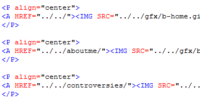Markup
From Just Solve the File Format Problem
(Difference between revisions)
Dan Tobias (Talk | contribs) (→Specialized markup) |
Dan Tobias (Talk | contribs) (→Specialized markup) |
||
| Line 38: | Line 38: | ||
* [[AIML]] (Artificial Intelligence Markup Language) | * [[AIML]] (Artificial Intelligence Markup Language) | ||
| + | * [[Fountain]] (intended for screenplays) | ||
* [[Opus Embedded Commands]] (OEC) | * [[Opus Embedded Commands]] (OEC) | ||
Revision as of 13:19, 5 October 2014
Markup languages express the structure and/or presentation of a document through the use of tags, elements, and embedded commands and codes. They are distinguished from programming languages, because instead of giving instructions to be executed, markup elements designate the nature, purpose, or style of text and media which is part of a document.
Contents |
General markup
Markup metaformats
- DTD (Document Type Definition); used to define document formats in markup languages
- XML Schema Definition
Text markup
- CommonMark (variant of Markdown, attempted to be more standardized)
- LaTeX (User-friendly version of TeX used by mathematicians, computer scientists etc)
- Markdown
- reStructuredText
- Scribe
- TEI (Text Encoding Initiative; Specialised dialect of SGML)
- TeX (TeX type-setting language created by Donald Knuth)
- Wiki markup
Web document markup
Specialized markup
- AIML (Artificial Intelligence Markup Language)
- Fountain (intended for screenplays)
- Opus Embedded Commands (OEC)
See also Document,Text-based data, and News media.
Links
- Remember the Nineties (complaint about how markup languages are still in use instead of more user-friendly WYSIWYG stuff)
